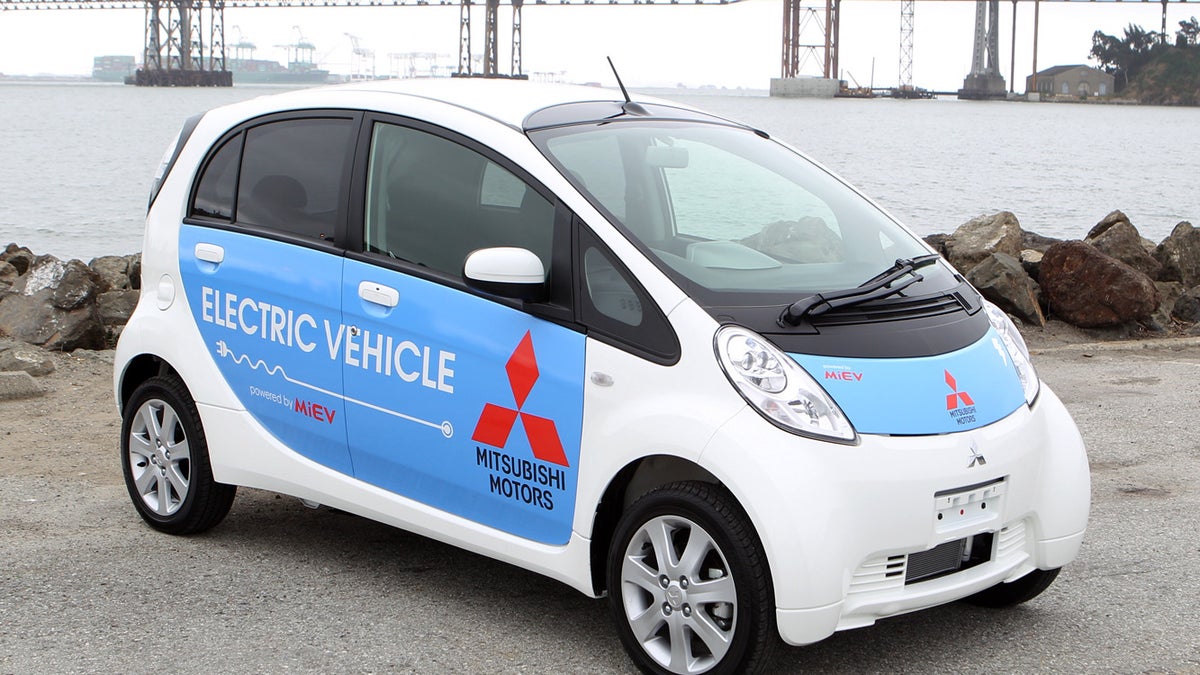Mitsubishi i-Miev in the city
CNET Car Tech spent some time with the Mitsubishi i-Miev in San Francisco.

The U.S. version of the Mitsubishi i-Miev electric car won't be here until next year, but we got to spend a week with the Japanese version to test out the power train and find out what life will be like with an electric car.
First of all, being a car built for the Japanese market, the steering wheel was on the wrong side. We found that fact relatively easy to cope with in the city, but this i-Miev also lacked anything like the cabin tech we will see in the U.S. version. It had merely a simple radio and a CD player mounted in the dash.
The Mitsubishi i, on which the i-Miev is based, was designed as a city car, so we found it easy to get along with it in the dense urban area of San Francisco. It is narrower than most American cars, which made it extremely comfortable to drive in traffic, as the lanes seemed very wide.
Its minimal length proved a big bonus when looking for parking spaces, as the i-Miev fit into curb spots most cars could not. That short length also gave us room to maneuver in traffic, making it easy to jump into openings in a line of cars.
But edging through traffic wouldn't be possible if the power train wasn't up to it. Although an electric car with only 63 horsepower, the 47-kilowatt motor's 133 pound-feet of torque gave the car the push it needed to drive through the tangled traffic of the city and make quick starts off the line.
Of course, we were always conscious of the fact that the i-Miev is an electric car, with a range that can be quickly sapped by a lot of hard acceleration. This thought generally kept us at moderate speeds. But we were happy that the i-Miev had the acceleration headroom to handle any situations that cropped up.
Although ready to jump forward quickly at speeds below 50 mph, a previous excursion on the freeway had shown us the limits of the i-Miev when traveling above 60 mph.
Impressively, the i-Miev had the guts to pull some of San Francisco's hills, but after the heavy accelerator work needed, we noticed an interesting ozone smell, the result of the battery giving up a lot of its charge to reach the crest.
The car does have a shifter, but this stick would more properly be called a drive-mode selector, as it is not connected to a transmission. The i-Miev uses a single-gear reduction transmission, as the electric motor has a higher rpm range than a gas engine so does not need a variety of different gear ratios.
Along with reverse and drive, there are also Eco and engine-braking modes, the latter signified with a B. In Eco mode, acceleration is reduced, and regeneration while coasting is increased. The B mode increases regeneration, but does not limit acceleration.
While driving the i-Miev, we were very conscious of its digital gauges, one showing battery level and the other showing range to empty. A center analog gauge contained blue, green, and clear areas, indicating regeneration, minimal battery usage, and power.
We found it easy to keep the car in the green area, labeled Eco on the gauge. It only entered the blue area when we let the car coast. The i-Miev does not have true regenerative braking, so we saw no additional recharge when we applied the brakes.
After spending a typical day driving around the city, the battery level stayed well above the halfway mark. This welcome observation is partly due to the fact that San Francisco measures approximately 7 miles by 7 miles, and the i-Miev has the juice to go 100 miles. Though it might take an hour to get across the city, very little juice gets consumed since most of that time is spent sitting in traffic or at stop lights.
Instead of waiting until the battery was almost dead, we recharged it whenever we could. From a 110 volt outlet, it would have taken 14 hours to completely recharge the battery, or 7 hours from a 220 volt outlet. As our driving used only a quarter or half of the charge, we never had to let it sit for the full 14 hours.
In a home-charging situation, we found that the i-Miev tripped breakers if there was much else on the circuit. We had to find a circuit with little existing load to plug in the i-Miev.
Considering the i-Miev's 100-mile range, we used an online mapping tool to look at areas within a 40 mile radius of a few downtown areas. We chose 40 miles as comfortably within the point-of-no-return range for a round trip. Of course, using a simple radius distance shows range as-the-crow-flys, and does not take into account real road mileage. But it is an interesting indication of the i-Miev's practicality.
You can check the radius for your own city with the Radius Around Point map tool.
The U.S. version of the Mitsubishi i-Miev electric car should be available at dealerships in late 2011. No pricing has been announced at this time.

